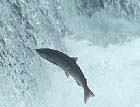The Tweed Comes up Trumps
As the Tweed offers up better catches than ever, gloomy forecasters who claim salmon fishing is in terminal decline may be forced to eat their words.


One tends to read rather more about salmon stocks being in terminal decline than one does success stories, but it is important in many respects to remember that there are those who are still optimistic for the future.
For instance, who would have thought that 20 years ago there would be salmon in the Tyne? And, some important work is being done by those determined not to be depressed by gloomy predictions, one of whom is Nick Yonge, of the River Tweed Commissioners
'We've had an average of 10,000 fish caught a year in the past ten years up until 2003, when we had 14,000, and so far this has been our best year ever,' he says proudly. Aided by the wet summer, but largely, thinks Mr Yonge, because of long term measures which are returning the river to what it was pre-industrial revolution, the river is giving up increasing numbers of fish, and not just salmon but trout as well.
'Agriculture following the industrial revolution ruined the waterways of much of the country and they are taking years to repair,' says Mr Yonge. 'People at the time concentrated on all the positives of industry but couldn't see the extent to which the future of the river would be affected,' he explains. He is now hoping to use some CAP money to build on this and to restore the water to its optimum level for all forms of life.
Breaking down barriers to salmon getting upriver to spawn is also crucial and although the Tweed has always been one of the best salmon rivers in the UK, it is set to get much better since fish can now swim up more tributaries like the Ettrick and Yarrow to spawn, where they can safely bring up the small fish until they are ready to make a run for the open sea
Another factor in the growth of salmon numbers has been a new policy whereby the first fish is always put back, but the second is kept, and the third goes back, and so on. This seems to go against everything anglers would want, but it has been proven that on average if one catches any fish at all, it is more likely you end up with an odd number, so therefore putting the first one back is crucial, and good anglers understand that if they want to be able to keep coming back to the same river, sacrifices must be made.
Not to mention that there are over 500 full time employees working on the Tweed, a meaningful figure at in a time where full-time rural jobs in the Borders are hard to come by. So next year should be rosier again, and anglers can stay safe in the knowledge that the price they pay for the best beats in the Tweed is worth every penny, and with dedicated work, salmon fishing doesn't have to be ruled out as a sport whose days are limited.
Exquisite houses, the beauty of Nature, and how to get the most from your life, straight to your inbox.
